 | Kangaroo LanieAmerica's Wild Girl | 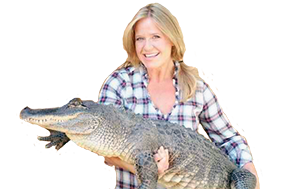
|
..And Her Animal Friends Seen at Events Nationwide | ||
|
| 

|
Kangaroo Lanie and her alligator Spike and Jungle Jack Hanna "stole the show" at the 39th Annual Daytime Emmy Awards at the Beverly Hilton Hotel on Saturday, June 23. Spike and Kangaroo Lanie were asked to appear on Good Day LA the following week.
 `
` 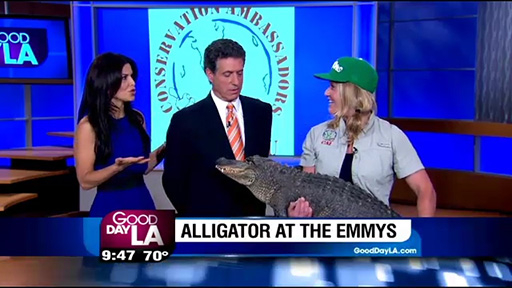
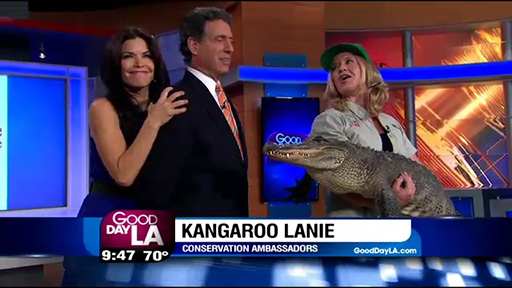
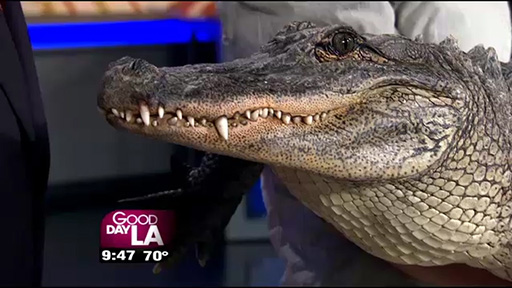
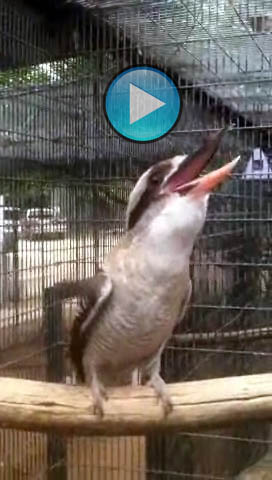 `
`
This Australian bird is the largest of the kingfishers and definitely the funniest! Known as the laughing kookaburra this rather small bird has a call that is both very loud, long, and downright funny - it sounds like laughter! The sound bite of the kookaburra's call has been used in the film and television industry for many years to imitate jungle noises and monkey sounds. The irony is that this kingfisher does not live on a continent with monkeys! It lives throughout many habitats in Australia and is often referred to as the bush mans alarm clock.
The kookaburra's long beak helps them to catch a variety of prey including insects, fish, small mammals and even snakes and lizards! Once they catch prey they beat it against tree branches and then swallow it hole - even long snakes!!
The kookaburra's name is a word from Wiradjuri guuguubarra, and is onomatopoeic of its call. Meaning that the name kookaburra is actually the sound that they make. An analogy would be if we referred to a dog as a ruff or a cat as a meow!
Giggles the kookaburra was with me at a special live appearance with Jungle Jack Hanna when the great grandchildren of Captain and Maria Von Trapp from the Sound of Music- Justin, Amanda, Melanie and Sofia Von Trapp performed live at the show. Justin Von Trapp made the kookaburra call during their rendition of a song from the Lion King. We all thought Giggles would be inspired by Justin's perfect call and join in...but instead he sat silently on my hand and just stared in awe at Justin and the other Von Trapp children! Can't say I blamed my feathery friend - I was staring in awe of their angelic voices too!!

Lemurs are primates found only on Madagascar. There are three main groups of primates - apes, monkeys, and prosimians (or pre-monkeys). Prosimians are considered old world primates and consist of lemurs, bush babies, galagos, pottos, tarsiers and lorises. What makes an animal a primate? One outstanding characteristic is thumbs!! Can you imagine a day without your thumbs?? Most primates have thumbs on their hands AND their feet! That's one reason that leaping from tree to tree is so easy for many lemurs!
Not all lemurs are arboreal, or tree dwelling. In fact many lemurs, such as the ring tailed lemur, are well known for their terrestrial hopping that looks like a dance. Some lemurs eat mostly fruit, such as the red ruffed and black and white ruffed lemurs. The lemur known as the aye-aye is a nocturnal species that eats only bugs! They even have super long, thin fingers to reach into tree bark to find hiding insects!
Lemurs and other prosimians are not monkeys so they do not have prehensile tails. That means that while many lemurs have beautiful, fluffy, long and impressive tails - they cannot hold onto things with them. The tail is mostly used to "show off" or display to other lemurs. Lemurs have an impressive sense of smell compared to other primates and they use it to find food and identify their territory. Lemurs are often seen basking in the sun and rubbing their scent glands on branches to mark their territory. While most lemurs are not big hunters - they have large canine teeth that they use for defense. Some of their natural predators in Madagascar include fossa, boa constrictors, and many birds of prey.
"Rufio" the red-ruffed lemur and "Bakari" the black and white ruffed lemur have been leaving their thumb prints on the hearts and minds of thousands of school children for nearly a decade. They are known to greet people in the typical ruffed lemur fashion - licking up your nose! Sometimes I think they are trying to lick my eyeballs through my nostrils!
 | Copyright 2012-2024, Kangaroo Lanie -- All Rights Reserved | 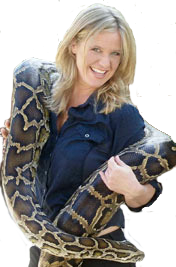
|
..And Her Animal Friends Seen at Events Nationwide | ||
|
| ||
|
Make sure to visit the Conservation Ambassadors Website. |